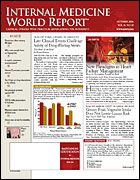Publication
Article
Internal Medicine World Report
Hantavirus Pulmonary Syndrome Cases in Humans on the Rise
An increase in the number of human cases of hantavirus pulmonary syndrome (HPS), a rodent-borne viral disease characterized by severe pulmonary illness and a case-fatality rate of 30%, has sparked concerns among experts at the Centers for Disease Control and Prevention (CDC).
From January to March 2006, a total of 9 confirmed cases were reported from Arizona, New Mexico, North Dakota, Texas, and Washington (MMWR. 2006; 55:627-629; see Figure). A comparable number of HPS cases were reported nationally during an earlier 5-year period (1994-1999), leading officials to speculate that human HPS infection could become even more common this year.
HPS is characterized by a febrile illness associated with bilateral diffuse interstitial edema of the lungs that develops within 72 hours of hospitalization in formerly healthy persons. Radiographically, the edema can bear a resemblance to acute respiratory distress syndrome. Other than supportive care, no treatment is available for hantavirus infection. The likelihood of surviving HPS improves with early detection, hospitalization, and aggressive pulmonary and hemodynamic support.
"All healthcare providers are strongly encouraged to become familiar with the signs and symptoms of HPS and to report suspected cases immediately to their state health departments," the CDC recommends.





